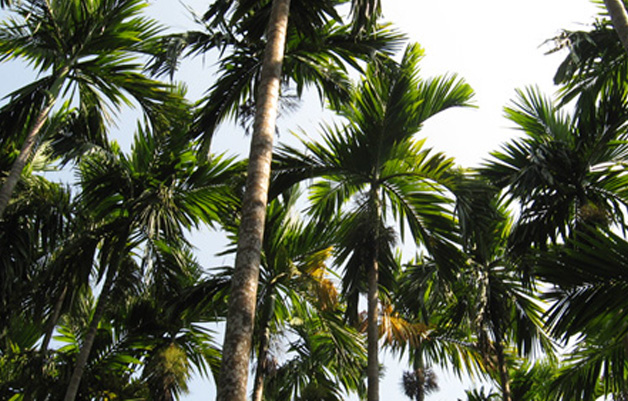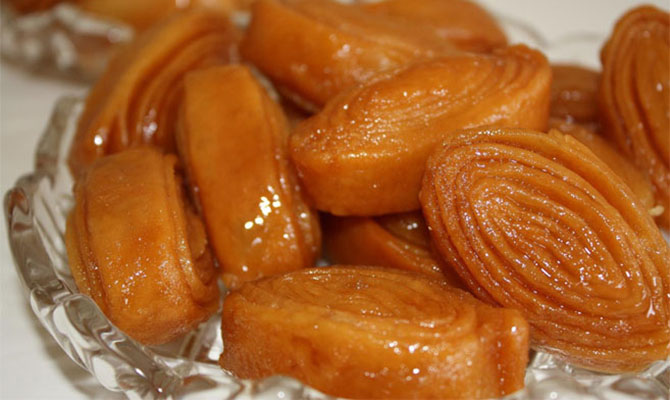Searching

Please wait
Tradiational Recipes of Honnavar
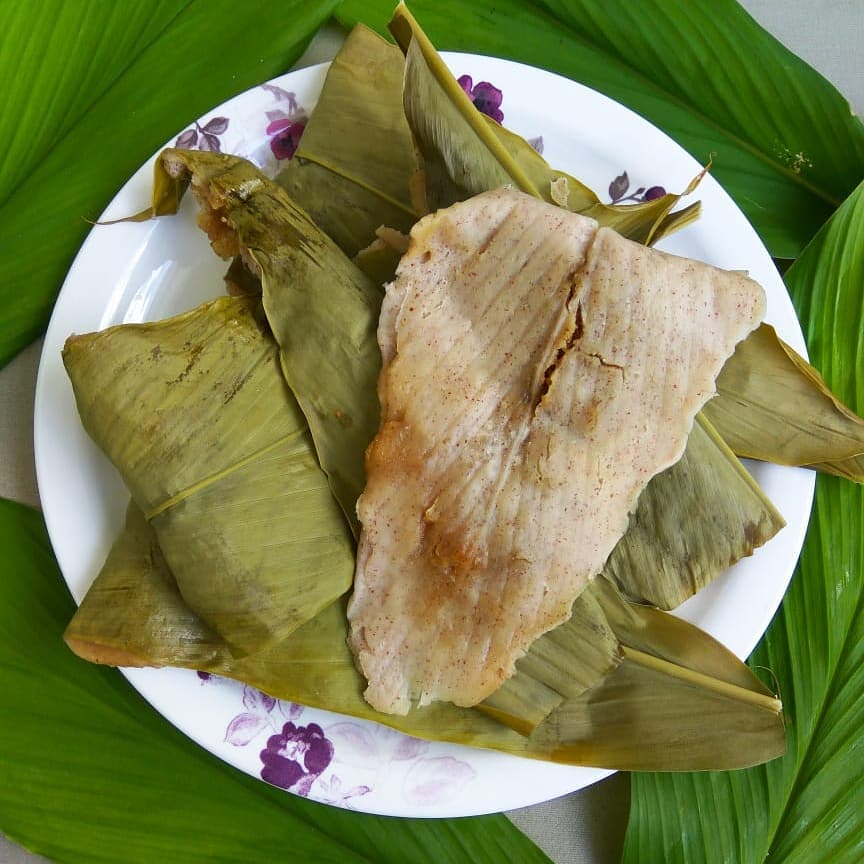
Ingredients:
- 10-12 Turmeric leaves
For the batter:
- 1 cup rice
- Salt to taste
- Jaggery to taste
- 1/2 cup beaten rice
- 1/2 cup grated coconut
- 1/2 cup powdered or grated jaggery
- 1/2 cup grated fresh coconut
- 1 cup broken puffed paddy (optional) (called laya pitto in Konkani)
- A pinch of cardamom powder
Preparation Method:
- 1.Soak rice for a minimum of half an hour and grind them in a mixer along with grated coconut, beaten rice, salt and jaggery into a smooth paste using just enough water needed to make a paste. Keep the ground, thick batter aside.
- 2.Wash the turmeric leaves carefully, drain all the water and wipe them dry using a cloth. Take care not to tear the turmeric leaves. Keep them aside.If the turmeric leaves are longer than the size of your steamer then chop off the stem portion of the leaf or else its a hassle while placing the patholis inside the steamer for steaming.
- 3.In a bowl mix together freshly grated coconut, grated jaggery and cardamom powder. Mix them well. Then add broken puffed paddy to the mixture and mix well.
The sweetness of the patholi depends on the amount of jaggery you have used while preparing the the filling (choornu). So, add in jaggery according to your palate, depending on how sweet you would like your patholis to be.The inner filling can be prepared without broken puffed paddy but the mixture tends to get a little watery without them. Broken puffed paddy absorbs the mositure that's given out when you mix grated coconut with jaggery.If you find whole puffed paddy then heat them for a minute until they get a little hot, powder them in a blender and then use them. - 4.On a clean working surface place a turmeric leaf and then place a small ladle of rice batter at one end of leaf. Spread it across the length of the leaf using your fingers or a spoon. Leave out the edges of the leaf to avoid spilling out of the batter when you press them closed. The rice batter should be applied as thin a layer as possible.
- 5.Place the inner filling mixture along the spine of the leaf, right in the centre, in the middle of the leaf. Patholi's sweetness also depends on the amount of filling (choornu) you place inside each patholi. So, if you want your patholis to be very sweet then place lots of filling (choornu) in the centre of each leaf.
- 6.Fold the leaf vertically into half, along the spine. Continue this process until all the leaves/rice batter is used up.
- 7.Place a steaming vessel with sufficient water on a high flame. When the water comes to boil, place the patholis inside the steamer. You can stack them up or place them evenly so that all of them get steamed evenly.
- 8.Cover and steam for 12-15 minutes on a high flame.
- 9.Once cooked, remove the hot patholis out, peel off the turmeric leaves and serve hot patholis with lots of ghee on top and enjoy!

INGREDIENTS
- Rice – 1 3/4 cup (Parboiled or Idli Rice)
- Split black gram (Dhuli Urad Dal) – 1/2 cup
- Sugar – 1 tsp + 2 tsp
- Instant dried yeast – 1 tsp
- Salt – 1 tsp or to taste
- Coconut milk – 1/2 cup
- Warm water – 1/4 cup
- Water for making paste
INGREDIENTS
- 1. Soak both the rice and urad dal separately in the water for 4- hours.
- 2. Drain and rinse the rice and dal.
- 3. Add water to rice and grind to make a smooth batter.
- 4. Add this batter to a large bowl.
- 5. Grind dal to make a thick and smooth batter.
- 6. Add dal paste to the rice batter.
- 7. Now add coconut milk to this batter and whisk well to make a lump free batter.
- 8. Add salt and 2 tsp sugar to this batter and whisk well. Set it aside.
- 9. To make the yeast solution; mix the yeast and sugar in a glass of warm water.
- 10. Stir well and let it rise for 10 mins.
- 11. Add this yeast mixture to the prepared batter and stir well to combine.
- 12. Cover the bowl and set it aside to ferment for about 2 hours or till it doubles in quantity.
- 13. Boil water in a large pot/pan or a steamer.
- 14. If you are steaming in a pot/pan then put a stand and a steamer bowl on it as shown in the video.
- 15. Grease the ramekins or idli moulds.
- 16. Pour the batter about 3/4 of the way into each mould and place it in the steamer.
- 17. Put the Idli stand/ ramekin dishes into a steamer and steam for 15-20 minutes at least or till cooked.
- 18. Remove the lid carefully and insert a toothpick to check if Sanna is cooked if it comes out clean then Sanna is ready. If not, steam for few more minutes. Keep aside.
- 19. When cooked, gently remove from the Idli moulds/ramekins from the steamer.
- 20. Let them cool down.
- 21. Once cool, remove carefully.
- 22. Serve hot with a curry or chutney of your choice.
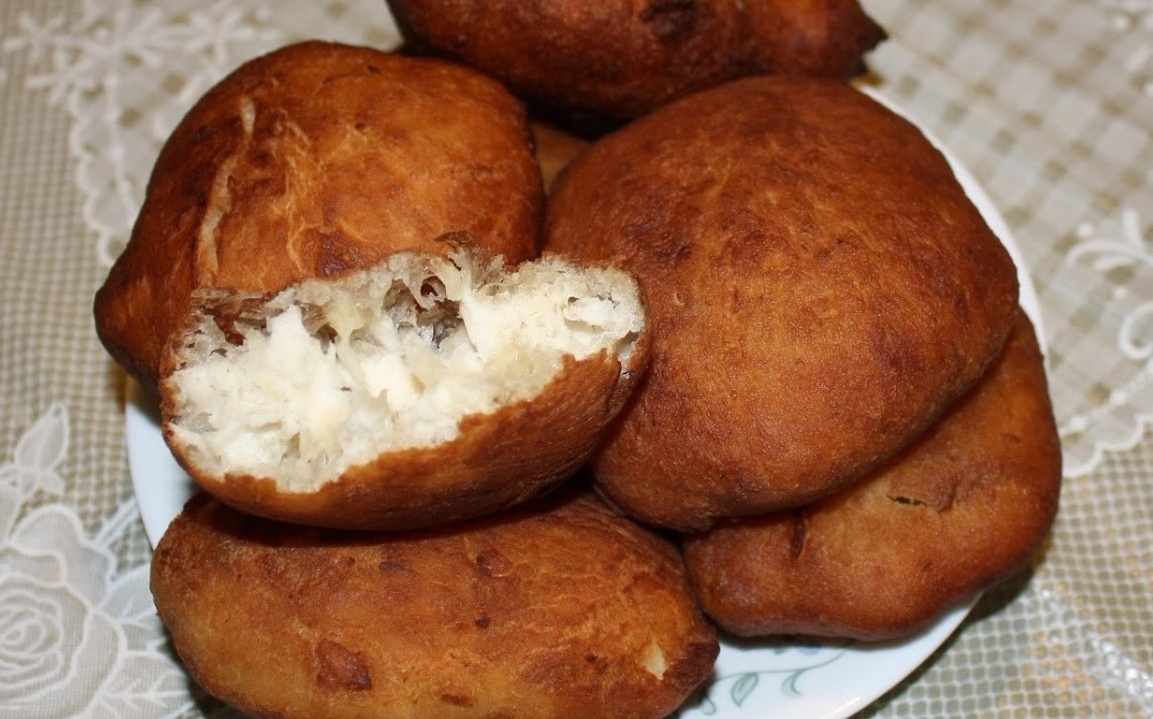
INGREDIENTS
- 2 banana, ripened
- 1 or 2 tbsp sugar
- ¼ cup curd / yogurt
- 1 tsp cumin / jeera
- pinch of baking soda
- ½ tsp salt
- 2 cup maida / plain flour / all purpose flour / refined flour
- oil for deep frying
INGREDIENTS
- 1. Firstly in a large mixing bowl take 2 ripened banana. if your having over ripened banana (black) it works great.
- 2. Add in 1 or 2 tbsp sugar depending on the sweetness of banana.
- 3. mash smooth with the help of fork. but do not blend banana in mixi.
- 4. Now add ¼ cup curd, 1 tsp cumin, pinch of baking soda and ½ tsp salt.
- 5. Combine well with a help of spoon.
- 6. Further add 2 cup maida and prepare dough.
- 7. Knead for 5 minutes or till dough turns smooth.
- 8. Grease the dough with a tsp of oil.
- 9. Cover and rest in warm place for 8 hours.
- 10. Next day, knead the dough slightly and pinch a ball sized dough.
- 11. Dust with some maida and roll slightly thick than poori.
- 12.Deep fry the buns in hot oil.
- 13. Further fry the buns on both sides keeping flame on medium.
- 14. Fry till banana poori turns dark golden brown in colour both sides.
- 15. Finally, serve the banana buns / mangalore buns / banana poori with chutney or saagu. you can also have them plain.
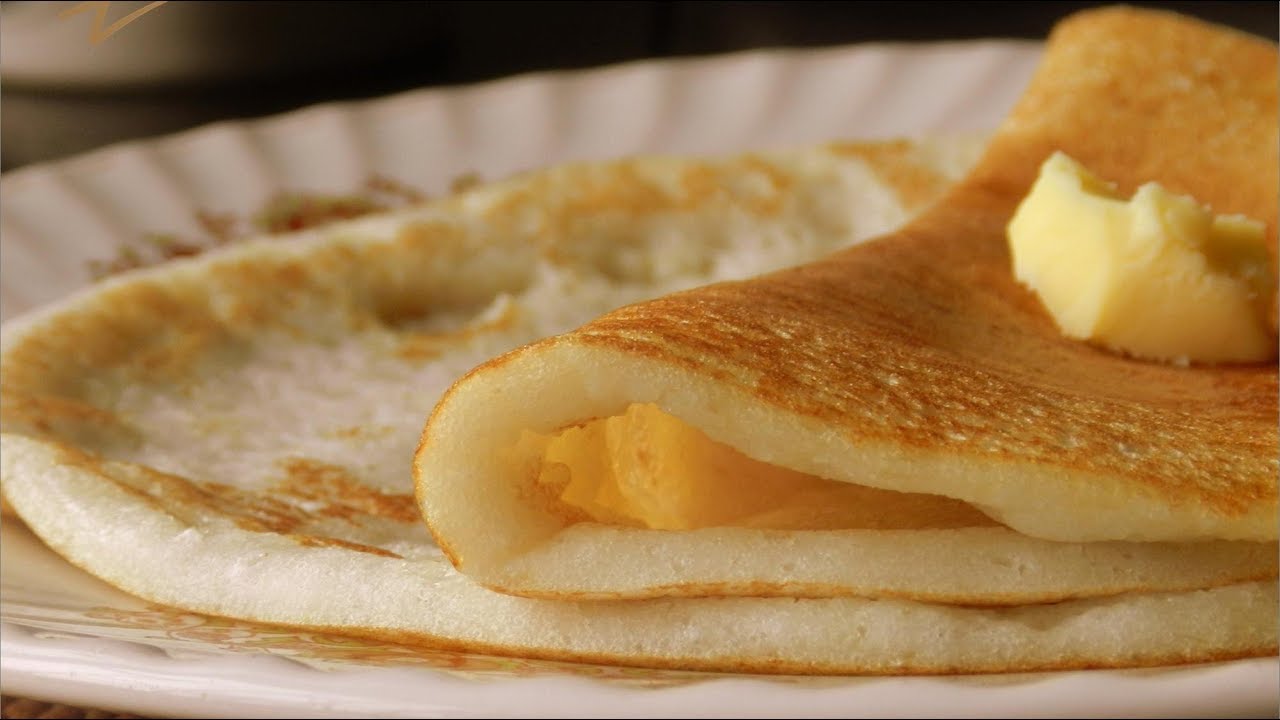
INGREDIENTS
- 1 Cup urad dal / split black lentils
- 3 Cup sona masuri rice / chawal / dosa rice
- ½ Tsp mehi / menthe / fenugreek seeds
- 1 Cup paper avalakki / beaten rice / thin poha
- Oil
- Salt to taste
PREPARING BATTER:
- 1. Soak urad dal and rice, methi in a separate bowl. add in enough water and soak for 5 hours
- 2. First drain the water from rice and blend to smooth batter. add water if required to make a smooth paste.
- 3. Transfer to a large vessel. and keep aside
- 4. Now blend urad dal to smooth fluffy batter.
- 5. Add a cup of paper avalakki to the blender. and grind to a smooth thick paste.
- 6. Transfer the batter into the same bowl and mix well.
- 7. Cover and ferment in a warm place for 12 hours.
INGREDIENTS
- 1. The next day you can see the batter has raised well indicating its well fermented.
- 2. Mix the batter slightly.
- 3. And now add salt to the batter and mix well.
- 4. Heat a non-stick tava and pour a ladleful of the batter on tava.
- 5. Spread the batter in a circular motion forming slightly thick circle.
- 6. Smear a little ghee over it and along the edges. cook on a medium-high flame till the dosa turns brown in colour and crisp.
- 7. Cover the dosa for a minute.
- 8. Surface of the dosa should look completely cooked in the presence of steam.
- 9. Then fry the dosa on other side until it turns golden brown.
- 10. Serve immediately with coconut chutney and sambar.
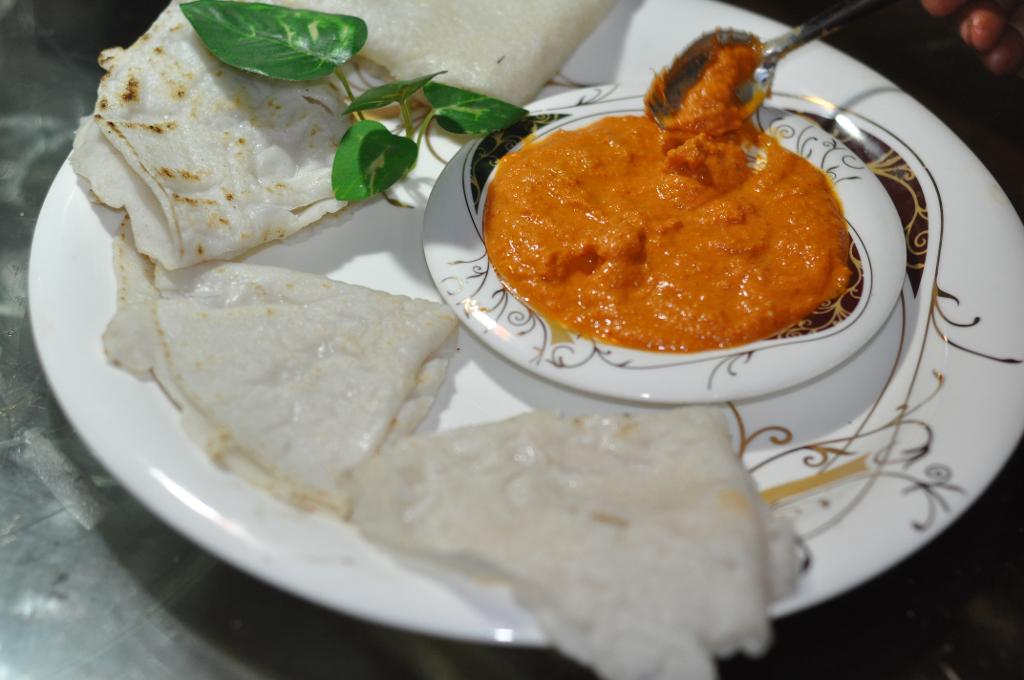
INGREDIENTS
- 1 Cup sona masuri rice / dosa rice
- ½ Cup coconut, grated
- 1 Tsp salt
- 2½ Cup water
INGREDIENTS
- 1. Firstly, soak 1 cup rice for 5-6 hours.
- 2. Drain off the water completely and transfer to blender.
- 3. Also add ½ cup coconut.
- 4. Blend to smooth paste without adding much water.
- 5. Now add 1 tsp salt and 2½ cup water.
- 6. Mix well making sure the batter is thin watery consistency.
- 7. Now carefully pour the dosa batter over hot tawa.
- 8. Cover and cook for 1 minute on medium flame.
- 9. Once the dosa is cooked completely, it is ready to serve. do not cook neer dose on both sides.
- 10. Finally, fold the dosa and serve neer dose / neer dosa immediately with mint chutney or coconut chutney.

INGREDIENTS
- ¼ cup sabudana / sago / saabakki / tapioca
- ½ cup water, for soaking
- 3 cups milk, full cream
- ¼ cup sugar, add more if required
- 10 cashews, halved
- 2 tbsp raisins / dry grapes
- ¼ tsp cardamom powder / elachi powder
INGREDIENTS
- 1. Firstly, in a small bowl soak sabudana in water for 30 minutes. soak more to reduce the cooking time.
- 2. Further, in a thick bottomed pan add milk.
- 3. Also add soaked sabudana along with water. you can discard the water, however, i feel the starch will be lost.
- 4. Boil the milk on medium flame.
- 5. Stir occasionally making sure it doesnt stick to bottom of pan.
- 6. Boil for 5 minutes or till the sabunda turns translucent.
- 7. Now add ¼ cup sugar. add more sugar if you like paysa / kheer to be more sweet.
- 8. Also add cashews, raisins and cardamom powder.
- 9. Mix well making sure everything is mixed well.
- 10. Simmer for another 20 minutes stirring in between.
- 11. Also the milk thickens.
- 12. Finally, serve sabudana kheer or sabakki paysa hot or chilled.

INGREDIENTS
- 1 cup Dosa rice , washed and dried completely
- 1/2 cup Fresh coconut , grated
- 1 tablespoon Salt
- 1 Onion , chopped
- 2 cloves Garlic , chopped
- 1 teaspoon Mustard seeds
- 1 sprig Curry leaves
- 1 cup Tamarind Water
- Salt ,to taste
- 1 pinch Asafoetida (hing)
- 1 sprig Coriander (Dhania) Leaves , chopped
- 2 tablespoon Coriander (Dhania) Seeds
- 1 teaspoon Methi Seeds (Fenugreek Seeds)
- 1 tablespoon Cumin seeds (Jeera)
- 1 tablespoon White Urad Dal (Split)
- 2 Dry red chillies
- 4 tablespoon Fresh coconut
INGREDIENTS
- 1. To begin making the Mangalorean style Basale Pundi Recipe (Steamed rice dumpling in Onion Gravy) we will make the pundi, wash the dosa rice and dry them completely.
- 2. Grind the rice in a mixer to a coarse mixture, add the grated coconut and blitz it one more time and keep it aside.
- 3. Heat a sauce pan with 1 cup water, add salt and leave it to boil. Add the ground rice mixture and start whisking continuously so that there are no lump formation.
- 4. Keep whisking till the mixture thickens and does not stick to the sides of the sauce pan.
- 5. Switch off the heat and allow it to cool, meanwhile keep a vegetable steamer ready with enough water to steam the dumplings.
- 6. Make a medium sized balls from the cooked rice mixture and place it on the plate of a steamer. Do for the entire mixture and steam the dumplings for about 20 minutes.
- 7. We will move ahead to make the curry, heat a small skillet with a teaspoon oil. Add coriander seeds, fenugreek seeds and roast them for 10 seconds. Later add the dry red chillies, cumin seeds, urad dal and roast them well too for another 10 seconds.
- 8. Take these roasted spices and grind it along with coconut in a mixer to a fine paste. Add little water to grind it smoothly.
- 9. Heat a kadai with oil, add the mustard seeds and splutter for few seconds and add the curry leaves and hing. Once that crackles add the chopped onions and garlic and saute till it becomes translucent.
- 10. Add turmeric powder, the ground paste, tamarind water and give it a stir. Check for salt. You can add 1 more cup of water and allow it to boil.
- 11. Once the dumplings are steamed enough, place them on a plate add a ladle of the gravy and sprinkle with coriander leaves.
- 12. Serve the Mangalorean style Basale Pundi Recipe (Steamed rice dumpling in Onion Gravy) as it is with a glass of Masala Chai Recipe - Indian Spiced Tea by the side for your morning breakfast.

INGREDIENTS
- 1 Cup medium rava or fine rava (semolina)
- 1/2 Cup grated fresh coconut or dessicated coconut (depending on softness and shelf life)
- 3/4 Cup sugar
- 2 Tbsp ghee
- 1/4 Cup boiled milk
- 8 - 10 Cashews broken
- 1 Tbsp raisins
- A Big pinch of cardamom
INSTRUCTIONS
- 1. Make a fine powder of sugar using mixer grinder and keep it aside.
- 2. Heat the ghee in a frying pan. Roast the broken cashews and raisins until raisins are puffed up. Take them out and set it aside.
- 3. Now to the same frying pan add in rava or semolina and fry until slightly brown under medium flame. This took around 7 - 8 minutes for me.
- 4. When the rava is done, add in coconut and fry for 2 more minutes.
- 5. Now transfer fried rava, coconut, roasted cashews and raisins and powdered sugar into a wide plate or bowl.
- 6. Mix well all the ingredients using hands.
- 7. Now sprinkle the milk for a small portion and start making laddus.
- 8. You have to sprinkle little milk to a small portion and make 2 - 3 laddus. Again sprinkle little milk to next small portion and make 2 - 3 laddus. You can add required milk to make the laddus.
- 9. Like this finish making all the laddus. These laddus will taste better after 1 - 2 hours of making. Serve and enjoy.
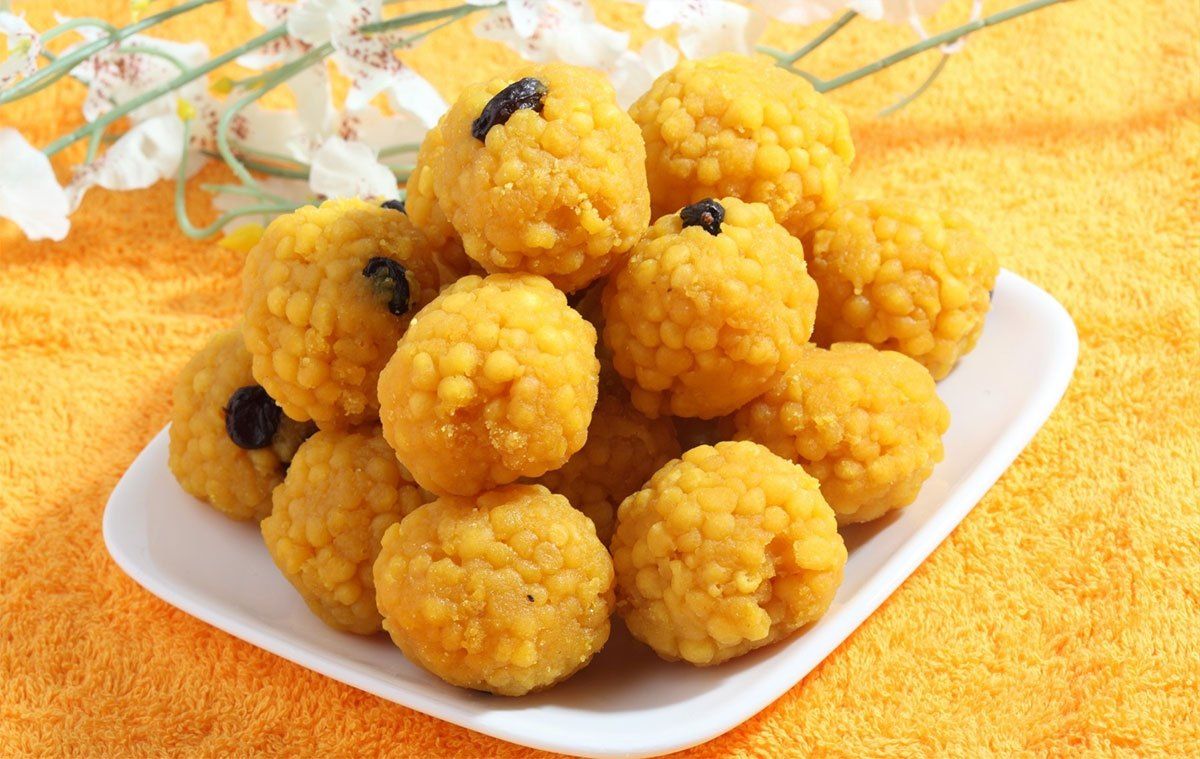
INGREDIENTS
- Chick pea flour (Besan flour)- 1 cup
- Water - 3/4 cup
- Cloves- 7 to 8
- Cashews- Handful
- Raisins- Handful
- Yellow food color or turmeric powder- 1/2 tsp
- Sugar candy- 2 tsp
- Cardamom- 5 to 6 or cardamom powder- 1/2 tsp
- Edible camphor- A pinch
- Baking soda- A pinch
- Salt- A pinch
- Cooking oil- 1.5 cup or enough for deep frying
- For sugar syrup
- Sugar- 1 cup
- >Water- 3/4 cup
Preparation
- 1. Sieve the gram flour in to a wide bowl. Add salt, baking soda and turmeric powder to it. Give a quick mix.
- 2. Pour water incrementally to the gram flour to make thick paste. Then make it thinner with little more water adding in steps. I have used up around 3/4 cup of water which may vary in your case. You need two slotted ladles for making boondi ladoo, so keep it ready.
- 3. Heat oil in a wide wok in medium flame, as it gets rightly heated check the consistency of gram flour batter. Using a spoon drop little batter in to oil, if it forms boondi with tail, then batter has to be thinner. On the other hand if flat boondi is formed instead of round, then the batter has to be thicker. So adjust accordingly. Hold slotted ladle over the hot oil and pour some gram flour batter over it. Then carefully tap the ladle so that round boondi drops in to hot oil. Wipe off the slotted ladle with a tissue paper before the next batch.
- 4. As the boondi gets cooked ( do not let it become crisp) remove it from oil using another slotted ladle and drain them over a kitchen tissue.
- 5. Continue the process of making boondi till the gram flour batter gets over.
- 6. Next heat a pan with sugar and 3/4 cup of water. Cook it with constant stirring. After a while swipe the ladle in the sugar syrup and check the consistency. If the syrup forms single string between your index finger and thumb then sugar syrup is ready. Switch off the flame, otherwise continue cooking till you get the right consistency.
- 7. In a wide bowl include boondi, cloves, broken cashews, raisins, sugar candy, edible camphor and cardamom powder. Mix and pour sugar syrup over it little by little. Combine everything well. When the mixture is warm, start rolling ladoo.
- 8.
- 9.
- 10.
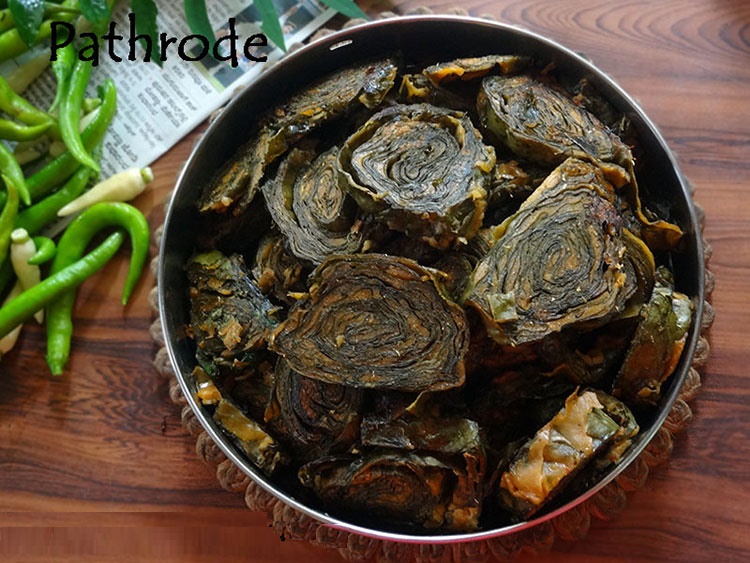
INGREDIENTS
Ingredients: (measuring cup used = 240ml)
- 16 medium sized colocasia leaves / Kesuvina ele
- 2 cups dosa rice
- 6 - 8 red chili (medium spice)
- 4 tsp coriander seeds
- 1 tsp cumin seeds or jeera
- 1/2 cup grated coconut
- 1 lemon sized tamarind
- Salt as per your taste
Ingredients for tempering pathrode (optional):
- 1/2 cup grated coconut
- 1/2 cup powdered jaggery
- 1 tsp mustard seeds
- 1 tsp urad dal
- 1 red chili
- 5 - 6 curry leaves
- 4 tbsp oil
-
Preparation
- 1. Sieve the gram flour in to a wide bowl. Add salt, baking soda and turmeric powder to it. Give a quick mix.
- 2. Pour water incrementally to the gram flour to make thick paste. Then make it thinner with little more water adding in steps. I have used up around 3/4 cup of water which may vary in your case. You need two slotted ladles for making boondi ladoo, so keep it ready.
- 3. Heat oil in a wide wok in medium flame, as it gets rightly heated check the consistency of gram flour batter. Using a spoon drop little batter in to oil, if it forms boondi with tail, then batter has to be thinner. On the other hand if flat boondi is formed instead of round, then the batter has to be thicker. So adjust accordingly. Hold slotted ladle over the hot oil and pour some gram flour batter over it. Then carefully tap the ladle so that round boondi drops in to hot oil. Wipe off the slotted ladle with a tissue paper before the next batch.
- 4. As the boondi gets cooked ( do not let it become crisp) remove it from oil using another slotted ladle and drain them over a kitchen tissue.
- 5. Continue the process of making boondi till the gram flour batter gets over.
- 6. Next heat a pan with sugar and 3/4 cup of water. Cook it with constant stirring. After a while swipe the ladle in the sugar syrup and check the consistency. If the syrup forms single string between your index finger and thumb then sugar syrup is ready. Switch off the flame, otherwise continue cooking till you get the right consistency.
- 7. In a wide bowl include boondi, cloves, broken cashews, raisins, sugar candy, edible camphor and cardamom powder. Mix and pour sugar syrup over it little by little. Combine everything well. When the mixture is warm, start rolling ladoo.
- 8.
- 9.
- 10.
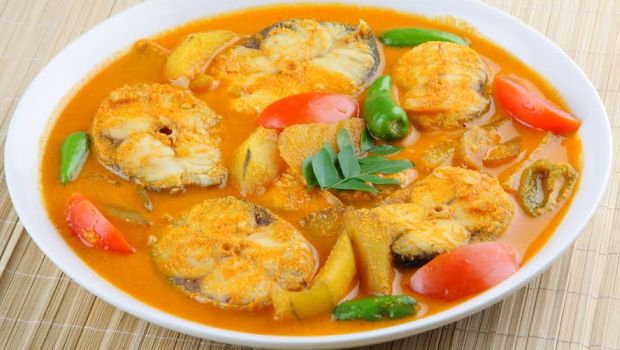
Ingredients:
- 6 Small Mackerels (about 450-500gm)
- 5-6 Curry leaves
- Salt to taste
- 1 Small onion
- 3 Tbsp grated coconut
- 1 Level tsp coriander
- 1 Pinch cumin seeds (jeera)
- 1 Pinch fenugreek seeds (methi)
- 1 Pinch carrom seeds (ajwain)
- 6 Peppercorns
- 3 Long dry chillies (Bedgi/Kumti/Kaddi)*see note
- 3 Short red chillies (Harekala)* see note
- 1 Green chilli (increase it to 2 chillies as per your spice tolerance)
- 1/4 Tsp turmeric pwd
- 1/4 Inch ginger
- 1 Marble size ball tamarind (or about 3/4th tsp pulp/paste)
- 4 Cloves of garlic (with skin) crushed
- 2 Tsp oil
Method
- 1. Descale and thoroughly clean the Mackerels and allow to drain in a colander.
- 2. Dry roast all the ingredients (except the ginger and tamarind) mentioned in ‘For the masala’ one by one. Remove and let cool. Then grind them along with the ginger and tamarind to a paste (needn’t be fine) using a little water.
- 3. In a pan place the fish, salt to taste and curry leaves and add the masala. Add about 1-1/2 cups of water (or less if you wish it a bit thick). Gently turn the vessel and shake it to enable the masala to mix with the water. Avoid using a spoon. Bring the gravy to a boil
- 4. When the gravy has come to a full boil, turn off the flame and in another smaller pan heat the oil for tempering and when it is hot, toss in crushed garlic with skin and stir for 3-4 seconds before adding it to the gravy
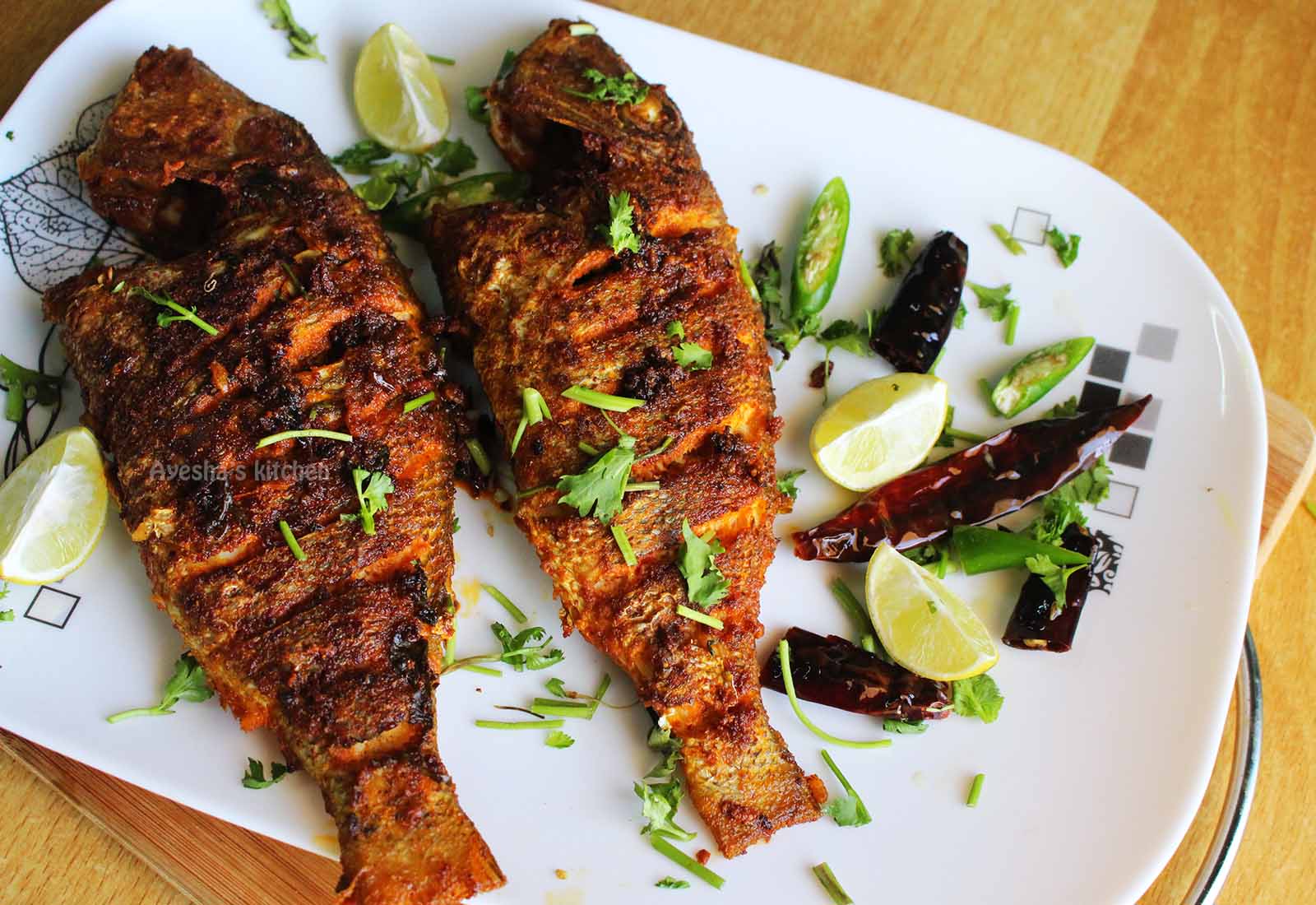
INGREDIENTS
- 3 0r 4 King Fish - big sized
- Salt to taste
- 1/2 tsp Turmeric powder
- 2 tsp (approx 8 to 10 garlic) garlic paste
- 3 to 4 tsp Red chilli powder (konkani home made masala)
- Oil for frying
INGREDIENTS
- 1. First put fish in a bowl of a 1 tsp salt and mix it well and keep for 5 to 10 minutes.
- 2. After 10 minutes wash the fish fillets with soft hand for 2 to 3 times and drain, because the fish is delicate.
- 3. Apply garlic paste, turmeric powder, homemade masala (konkani masala), and salt. Mix well and rub gently this marinate on fish.
- 4. Marinate for minimum half an hour.
- 5. Heat 2 tbsp oil in the grill pan or griddle, then add the fish when the pan is hot.
- 6. Cook on a medium flame. Turn the fish once the side looks golden brown. Fry the fish on a low flame till done. Should be cooked in a total time of 10 mins. (Do not overcooked)
- 7. Garnish with freshly chopped coriander.
- 8. Serve it with Chapati’s, Salad & Lemon Wedges.
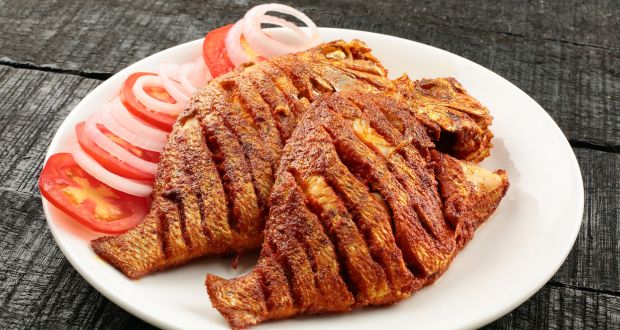
INGREDIENTS
- 2 Pomfret fish
- 1 teaspoon Turmeric powder
- Salt , to taste
- Cooking oil
INGREDIENTS
- 1. Heat a flat skillet on medium heat, dry roast the grated coconut, red chillies, garlic, ginger, green chillies, cumin seeds and cardamom pods.
- 2. Saute them for a couple of minutes until you can smell the roasted aromas coming through. You will also notice the coconut turning lightly brown.
- 3. Once that is done, grind the roasted konkani masala in a mixer by adding little water to a coarse paste.
- 4. Apply the ground konkani masala well onto the fish, and coat it well on either side. Rest the fish in the marinade for at least an hour - cover with a foil and keep the fish aside.
- 5. Once the fish has marinated; heat oil over medium heat on a skillet. Place the marinated pomfret/ fish and cook on either side for about 5 minutes.
- 6. Make sure the masala is stuck well on to the pomfret, you can use your hands and apply the leftover marinated masala on to the fish as well. Cook the pomfret, so the steam enables it cook evenly inside out.
- 7. You will notice as its steaming the masala will also turn lightly brown, hence ensure that the heat is on medium low heat - so the masala does not burn. Flip and ensure you roast the other side of the Konkani Pomfret Fry until cooked through.
- 8. Once done, turn off the heat and place the Konkani Style Pomfret Fry on a serving platter and serve hot.
- 9. Serve the Konkani Style Pomfret Fry Recipe along with some pickled onions and lemon wedges as an accompaniment to Kerala Style Fish Curry Recipe and Steamed Rice to make weekend lunch meal.
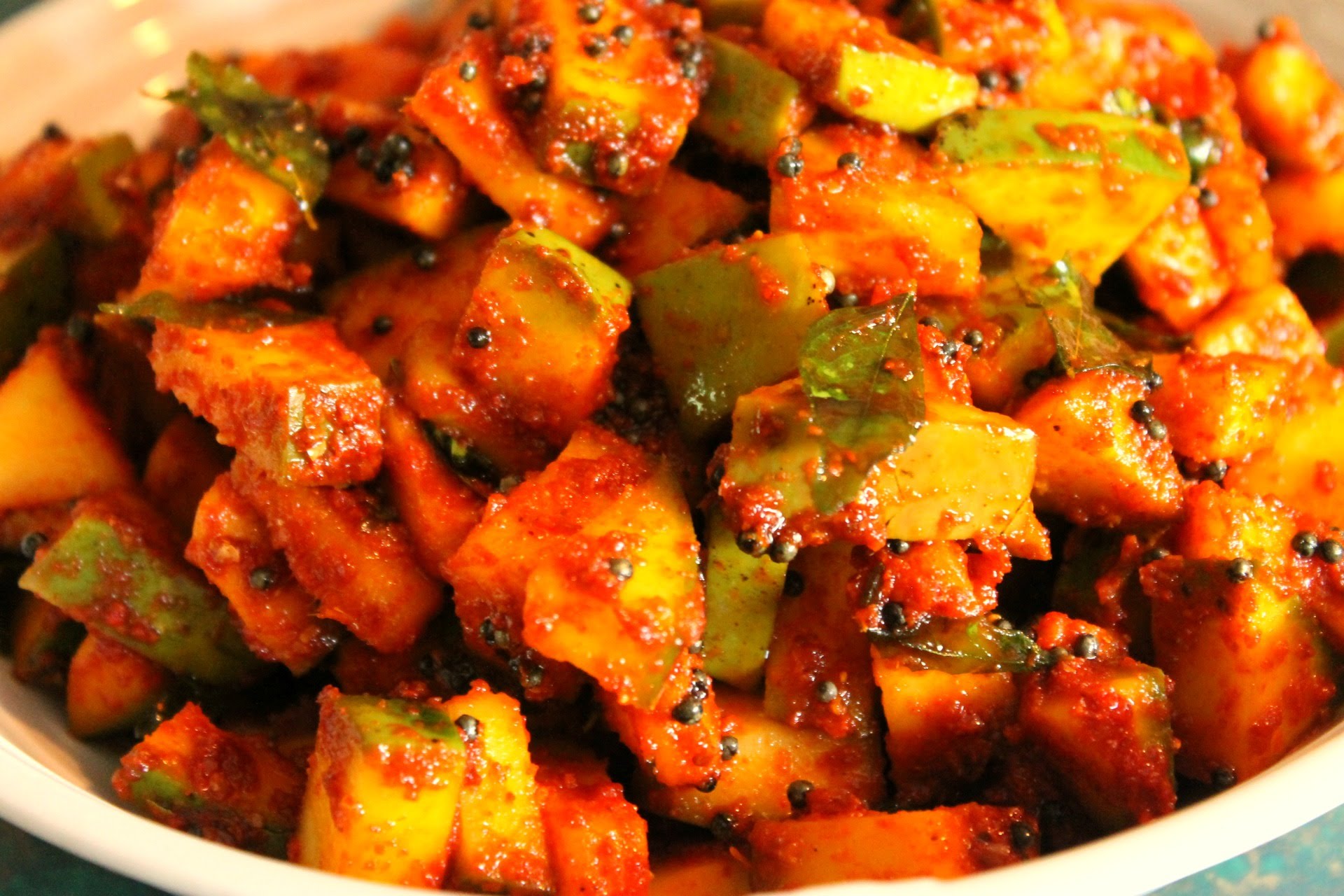
Processing time: 2-3 days
Preparation time: 15 minutes
INGREDIENTS
- Raw Green Mangoes (chopped Ambuli/ Kairi/ Tor/ Maavinkai) - 4 cups
- Red Chillies (Byadgi [15] + Red Chillies [15] ) - 30
- Turmeric powder - 1/2 teaspoon
- Mustard seeds - 1 tablespoon
- Asafoetida ~ Edible globular gum (globular edible gum which is non-powdery) - 1/3 teaspoon
- Salt
- Water
Method:
- Wash and chop Raw Green Mango into bite sized pieces. Add good enough salt and leave them aside (salt cure) for 2-3 days. Store and refrigerate if required. This is called 'Karmbi'. The day you are making pickle, thaw them and leave aside. Grind Red Chillies in grinder, add Turmeric powder and globular Asafoetida and Mustard seeds towards the end. Do not add salt as the Mangoes already have salt. Allow the powder to cool off for couple of hours. Spread on a wide tray if required. Once cool, add the powder to Mango pieces, add enough water as desired. Mix well. Asjust and add salt if required. Leave aside for couple of hours. Store the pickle in a clean non-reactive glass/ ceramic/ porcelain jar. Refrigerate and consume within 2-3 weeks or till the Mangoes do not turn squishy and soft.

